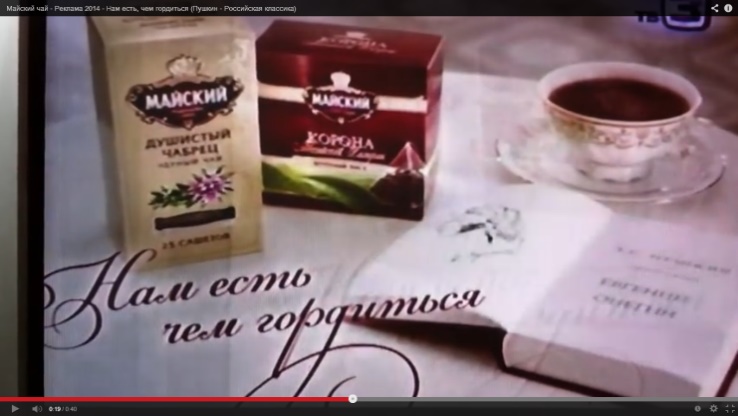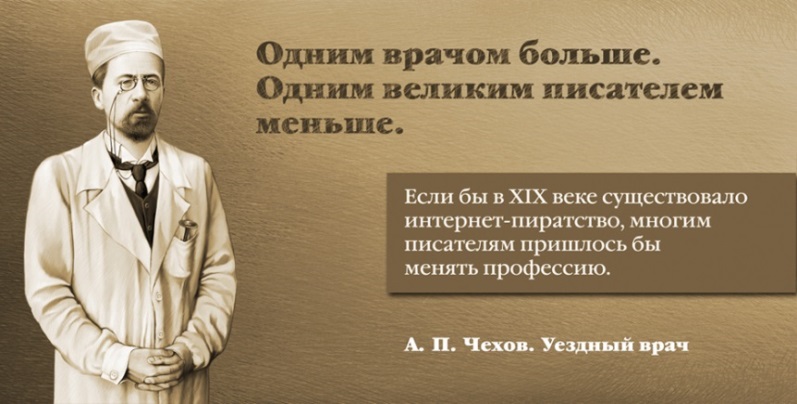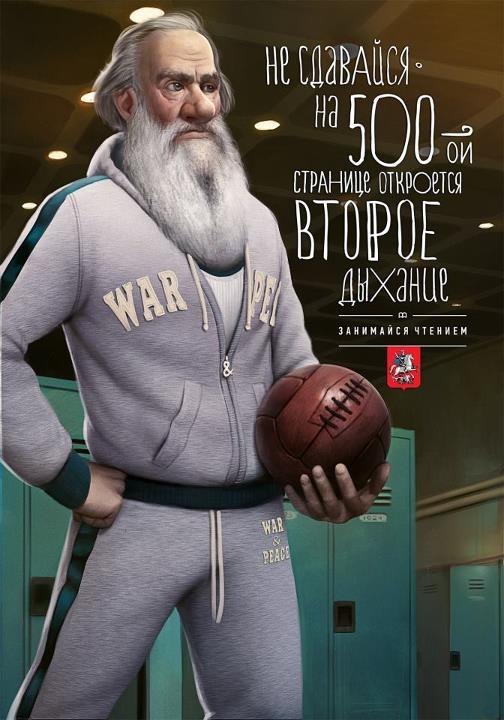Abstract
The article contains the analysis of using examples of Mikhail Lermontov, Alexander Pushkin, Leo Tolstoy and other authors’ works and images in Russian advertisement. The purpose of the article is to identify the motives and typical methods of using classic literature in modern advertisement. The research materials are represented by commercials on Russian national television channels (such as Russia-1, Channel One, NTV, REN TV, STS) in 2011-2018, archive video materials of different years published on YouTube, and outdoor advertising. We used similar advertisements of two previous decades interpreted in the context of main subject of present research. According to presented data, the main motives of using classics works are the following: appeals to classic symbols to confirm the product’s greatness; quoting of classics to form loyal attitude to the product; using of pictures and biographies of Russian writers in the context of social promotion of reading, and using the elements of classical art to attract mass audience. In recent years there is significant increasing of using Russian classic literature in the advertisement despite its rare using. The increasing amount of “classical advertisement” is caused by several significant dates, the rising interest of citizens in Russian culture, and also by achievement of a qualitatively new level in production of Russian national advertisement. Long-term studying of the present problem lies in the field of further data collection for a deeper understanding and analysis of the interaction between literature, art and advertising in the modern world.
Keywords: Advertisementadvertisement motivesadvertisingadvertisement symbolclassicsLermontovPushkin
Introduction
Advertising was originally in the field of economic scientific interest (Bove & Arens, 1995; Sandage, Fryburger, & Rotzol, 2003; Reeves, 1961; Kotler, 2016; Ogilvy, 2013; Romat, 1995; Pankratov, Bazhenov, & Shakhurin, 2015; Kuznetsov, 2014). On the one hand, today advertising is regarded as multifunctional sociocultural phenomenon which reflects commercial offers and helps to guide a customer. On the other hand, it gives customer the vision of modern ideal life codes (Prokhorova, 2013). These multifunctional discoursive approach is reflected in the works of Coquelin (2002), Barth (1996), Benjamin (2004), Baudrillard (1995, 2000), Morozova (2002), Pirogova and Parshin (2000), Uchenova (2015), Feshchenko (2003), Aniskina (2016). First of all, we are interested in the impact of behavioral stereotypes through transformation of imagery in advertising, and in particular of Russian classic literature images. The main stimulus of the research (which was started in 2014) was caused by some significant dates: 200 years since the birth of the Mikhail Lermontov (2014), Year of Culture (
Problem Statement
The problem of the interaction of classical art and modern advertising is highly relevant, as evidenced by the defense of several dissertations on this topic (Anashkina, 2009; Voychenko, 2012). Most of the existing works are devoted to the use of classical music and not literature in the world and national advertising (Gromadin, 2009). Insufficient attention has been given to the analysis of advertising from the point of view of its contact with the classical literature. Literature and advertising are considered to be antagonists. Modern theorists talk about the interaction of these cultural phenomena (Steinman, 2013). The problem of the influence of classical texts and images on consumers through the prism of modern advertising has not yet been studied, but has already been comprehended.
Research Questions
We tried to answer the following questions:
How often are Russian classic literature and images of classics used in modern advertising?
What motives do advertising makers use when using Russian classical literature in their work?
What kind of results do they want to achieve using quotes and images of the classics?
Purpose of the Study
The purpose of our research is to analyze advertising using classical literature, link it with the previous experience of advertisers and outline certain trends in the development of modern advertising. We want to determine the motives and typical methods of reference to classical literature.
Research Methods
In the present research we used general theoretical and scientific methods: studying of theoretical literature; content analysis of advertisements broadcast on the national TV channels; method of statistic generalization; method of empirical generalization; quantitative analysis of advertisement, etc.
Having conducted content analysis of 1545 advertisements (such as commercials, billboards, posters, etc.) broadcast on main Russian national channels (Russia-1, Channel One, NTV, REN TV, STS), Russian sector of YouTube, and on the streets of Russian cities over the past 8 years, we found only 11 cases of reference to the classics. The following table (Table
Findings
According to analyzed data and comparing them with analogical advertising facts of the previous years, we have formulated 4 main motives of appealing to classics.
Appeals to classical symbols to confirm “greatness” of the goods;
Quoting of classic authors to form loyalty to the product;
Using portraits and biographies of the authors in social promotion of reading culture;
Using elements of classic art to attract mass audience.
Let us consider each motive in more details.
Appeals to classical symbols to confirm “greatness” of the goods
The last example of poem quoting was used by Toyota. New car’s advertisement issued in 2018 is accompanied by verses of a poem “Do not be afraid of thick fog” by modern classic Yevgeny Yevtushenko. The advertisement appeals to a strong man who is able to overcome any obstacles in life thanks to the faithful iron horse.
Approximately the same appeal had already been used four years earlier by a competing company. The Mercedes-Benz 2014 video (in the year of the 200th anniversary of M. Lermontov) used a phrase from Lermontov's poem “Parus” “And he, the rebel, asks for the storm” in a truncated version - “The rebellious, asks for the storm”. “It has to go through thousands of storms, and you only have one - a storm of emotions!” is listed in the car’s advertising description on the official website of Mercedes-Benz GLA (https://www.youtube.com/watch?v=9KvyjGVumtg).
According to a composer and a blogger Gromadin (2009):
This idea can be fully transferred to the use of classical literature in advertisement (Figure

The musical and literary classical culture was united by a series of commercials of the brand “Maiski tea” in 2014 - 2016. In the video of 2014, images of two classics are used at once - Alexander Pushkin and Leo Tolstoy. A fragment of the audio recording of "Eugene Onegin" sounds: “her heart had long been overrun…” (https://www.youtube.com/watch?v=VbTmxf2SBX4). This commercial demonstrates a noble waltz reminding the waltz of Natalya Rostova. This is also achieved through recognizable music – “Waltz” by Aram Khachaturian from the film “War and Peace”. The 2015 commercial is fully devoted to Pushkin's work - we are shown the author himself and, apparently, the most important items for creativity - goose feathers, candles, tea. The final 2016 commercial of the whole series contains the quote from “Eugene Onegin” describing the tea party. The video series demonstrates a picture where Pushkin, played by S. Bezrukov, with his wife and children, drinks tea and draws inspiration for writing sounding lines.
Car and tea advertisement (see № 1-5 in Table
Quoting of classic authors to form loyalty to the product
Close to reading Russians in spirit was the advertisement of the Internet browser Google Chrome. The video starred writer Victoria Tokareva and her granddaughter Catherine Todorovskaya. Video shows two parallel youths of grandmother and granddaughter. While a granddaughter is reading the book of the Silver Age poets from the tablet and watching Bella Akhmadulina’s presentation on YouTube, a young grandmother is standing in an endless queue for a new book of poems. The final phrase in the commercial: “I think if grandma had Internet then, she would have spent even more time there than I did” (https://www.sostav.ru/publication/google-zapustil-kampaniyu-dlya-vas-7414.html). Here the poet's quote is used to attract the target audience. In our opinion, it is one of the successful advertising works, bringing the object of advertising closer, as well as the advertisement itself, to works of art.
The method of quoting poets of the Silver age is used, according to our observations, by the authors of modern advertisement since the mid-90s. Then Timur Bekmambetov successfully advertised Slavyansky Bank by quoting poems of Osip Mandelstam, Alexander Blok, and Boris Pasternak (Stepanov, 2015). In 2005 a successful experience was repeated by the advertising company “Rodnaya Rech” (Native speech), which released two ads for the mobile operator “MTS”: “The Exam” and “The Train” with fragments of poems by Alexander Block (“Night, street, lantern, pharmacy...”) and Igor Severyanin (“Romance”).
Classics for the culture of reading
Another reason to appeal to the classics is the promotion of reading culture in social advertisement and advertisement of bookstores (see № 8-10 in Table

Writing on the poster above (Figure
The authors of another series of 2012 social advertisement “Read out” have chosen the same pattern. These posters were designed for young audience and portray Leo Tolstoy, Alexander Pushkin, and Anton Chekhov as fitness trainers. The message of these posters is that reading books is as good as playing sports. The poster with Anton Chekhov says: “Three sets of 7 pages on a daily basis, and you will see result after a week”. On the poster below, Leo Tolstoy is portrayed as a trainer for trained readers, the writing says: “Don't give up - on the 500th page a second wind will open”.
On the trainers’ sport suits, we can find symbolic references to famous works, represented as sport labels: image of a seagull on Chekhov’s suit and the writing “WAR & PEACE” on Tolstoy’s suit (Figure

Using elements of classic art to attract mass audience
In our opinion, the examples above are relatively good in appealing to the classics. Nevertheless, it is difficult to use these types of advertisement without hurting the feelings and tastes of readers. The possible reason of it is that the main target audience of this advertisement is different (Ogilvy, 2013). This audience is simpler and knows about represented books from school curriculum. For these audience “aggressive advertising” with direct appeal is more effective, because it uses more familiar symbols to increase the selling of goods and services, and do not care about people's true attitude to it (see № 7 and 11 in Table
In the “Rossiysky Kredit” (Russian credit) bank deposits outdoor advertisement, which appeared on the streets of Russian cities in October 2014 (see more in Salnikov, 2014), we can see the using of “Mayakovsky” type of advertisement. These type is characterized by using poetic form with call-up phrases (High interest deposit! Catch the revolutionary moment!), pseudo-revolution aesthetics, and grotesque. It appears in red and black design, sans-serif letters, and the image of red man. This advertisement stylizes the famous Vladimir Mayakovsky’s “okna ROSTA” posters. Moreover, the grotesque effect of the present advertisement is represented by discordance between the “revolutionary” concept and the quite traditional interest rate of deposit (11 %).
The last example is the 2011 advertisement of “Baltika” beer, which also uses the works of Mikhail Lermontov and Alexander Pushkin. This commerical presents a poem about “classic beer” using the phrases from Lermontov and Pushkin’s works: “So what is a classic in Russia?”, “Yellow waves of cornfield”, “The water – “like genius of the purest grace””, “And hop – “high ideals inspire him””, “Combined in the beautiful “league of ours””, “Classic taste, unchangeable over the years!”. And in the end of the commercial comes the slogan: Baltika – all about the components of classical taste in the special series. Anashkina (2009) in her work “Advertising image as an invariant of art in modern culture” concludes that: “The phenomena of postmodernism culture has more thraits of artistic forms, and advertisement appears in these general pattern as a model of modern culture with artistic form but with pseudo-artistic content” (p. 15). We assume that advertisement of “Baltika” beer is the right example of these statements. But we can not agree that advertisement always had pseudo-artistic content. There are more appropriate examples that contain modern and classic art.
Conclusion
According to the analysis of advertisement examples, we can summarize the following conclusions:
To enforce the link between advertising product with Russian history and cluture, advertising makers refer to the main classic authors of Russian literature: Alexander Pushkin, Leo Tolstoy, Fyodor Dostoevsky, and Anton Chekhov. In this case, as a rule, they use not so much the artistic images created by the authors, as the portraits of the writers themselves. To associate or compare the object of advertising with a specific image or symbol, advertising makers refer to the works of Leo Tolstoy (the symbol of the Russian nobility), and Mikhail Lermontov with his capacious images - labels such as "yellowing cornfield" and "rebellious sail." To form loyal attitude and love for a good or service, advertising makers use quotes of the Silver Age poets (Alexander Blok, Igor Severyanin, Osip Mandelstam, Marina Tsvetaeva, Daniil Kharms). During last years there are increasing numbers of refers to classical authors in modern Russian advertising. The main reasons for this is the significant dates, increasing interest in Russian culture, and qualitatively new level in production of Russian national advertisement.
References
- Anashkina, N. A. (2009). Reklamnyj obraz kak invariant hudozhestvennogo v sovremennoj kul'ture [Advertising image as an invariant of art in modern culture] (Doctoral Dissertation). Omsk: Omsk State Technical University.
- Aniskina, N. V. (2016). Modeli analiza reklamnogo teksta [Models of advertisement text analysis]. Moscow: IL.
- Barth, R. (1996). Mythologies. Moscow: Sabashnikovs Publ.
- Benjamin, W. (2004). Masks of time: essays on culture and literature. Saint Petersburg: Symposium.
- Bove, K., & Arens, W. (1995). Modern advertising. Tolyatti: Dovgan.
- Baudrillard, J. (1995). The System of Objects. Moscow: Rudomino.
- Baudrillard, J. (2000). Symbolic Exchange and Death. Moscow: Dobrosvet.
- Coquelin, A. (2002). Aesthetics in front of face of techno-images. Decorative Art, 1.
- Feshchenko, L. G. (2003). Struktura reklamnogo teksta [Advertisement text structure]. Saint Petersburg: St. Petersburg Institute of Printing.
- Gromadin, V. (2009). Klassika v reklame [Classics in advertising]. Retrieved from http://gromadin.com/texts/podborki/383
- Kotler, P. (2016). Principles Of Marketing. Moscow: Williams.
- Kuznetsov, P. A. (2014). Sovremennye tehnologii kommercheskoj reklamy [Modern technologies of commercial advertising]. Moscow: Dashkov & Co.
- Morozova, I. G. (2002). Reklamnyj stalker. Teorija i praktika strukturnogo analiza reklamnogo prostranstva [Advertising stalker. Theory and practice of structural analysis of advertising space]. Moscow: Gella-print.
- Morozova, I. G. (2002). Slagaja slogany [Making slogans]. Moscow: RIP-holding.
- Ogilvy, D. (2013). Ogilvi o reklame [Ogilvy on Advertising]. Moscow: Mann, Ivanov & Ferber.
- Pankratov, F. G., Bazhenov, Y. K., & Shakhurin, V. G. (2015). Osnovy reklamy [Advertising basics]. Moscow: Dashkov & Co.
- Prokhorova, S. N. (2013). Reklamnyj diskurs [Advertising discourse]. Yaroslavl: P. G. Demidov Yaroslavl State University.
- Pirogova, Y. K., & Parshin, P. B. (2000). Reklamnyj tekst: semiotika i lingvistika [Semiotics and linguistics of the advertising text]. Moscow: International Institute of Advertising, Grebennikov Publ.
- Prudinnik, T. (2013). Anti-piracy project “We against of world without books!” starts. Retrieved from: http://pro-books.ru/news/3/12312#ixzz5emVfcvny
- Reeves, R. (1961). Reality in Advertising. New York: Knopf.
- Romat, E. V. (1995). Reklama v sisteme marketinga [Advertising in the marketing system]. Kharkiv: NVF Studcenter.
- Sandage, C., Fryburger, V., & Rotzol, K. (2003). Theory and practice of advertising. Moscow: Progress.
- Stepanov, D. (2015). World history by Imperial bank: how commercials were filmed. Retrieved from https://blogbankir.ru/bank-imperial-reklama.html
- Salnikov, A. M. (2014). Izmerenie jeffektivnosti reklamy na shtenderah [Measuring the effectiveness of advertising on pillars]. Reklama. Teorija i praktika [Advertising. Theory and practice], 3, 164-177.
- Steinman, M. A. (2013). FAQ: Vzaimodejstvie reklamy i literatury (7 faktov o kommunikacijah vysokoj i massovoj kul'tur v sovremennom mire) [FAQ: Interaction of advertising and literature (7 facts about the communication of high and mass cultures in the modern world)]. Retrieved from https://postnauka.ru/faq/18852
- Uchenova, V. V. (2015). Istorija reklamy [History of advertising]. Moscow: UNITY-DANA.
- Voychenko, A. A. (2012). Kul'turno-istoricheskie alljuzii v reklame: jesteticheskij aspekt [Cultural and historical allusions in advertising: aesthetic aspect] (Doctoral Dissertation). Moscow: Moscow State Institute of Culture.
Copyright information

This work is licensed under a Creative Commons Attribution-NonCommercial-NoDerivatives 4.0 International License.
About this article
Publication Date
20 April 2020
Article Doi
eBook ISBN
978-1-80296-082-2
Publisher
European Publisher
Volume
83
Print ISBN (optional)
-
Edition Number
1st Edition
Pages
1-787
Subjects
Discourse analysis, translation, linguistics, interpretation, cognition, cognitive psychology
Cite this article as:
Kudryavtseva, O. S., & Annenkova, N. A. (2020). Russian Classic Literature In Modern Advertisement. In A. Pavlova (Ed.), Philological Readings, vol 83. European Proceedings of Social and Behavioural Sciences (pp. 419-427). European Publisher. https://doi.org/10.15405/epsbs.2020.04.02.47
